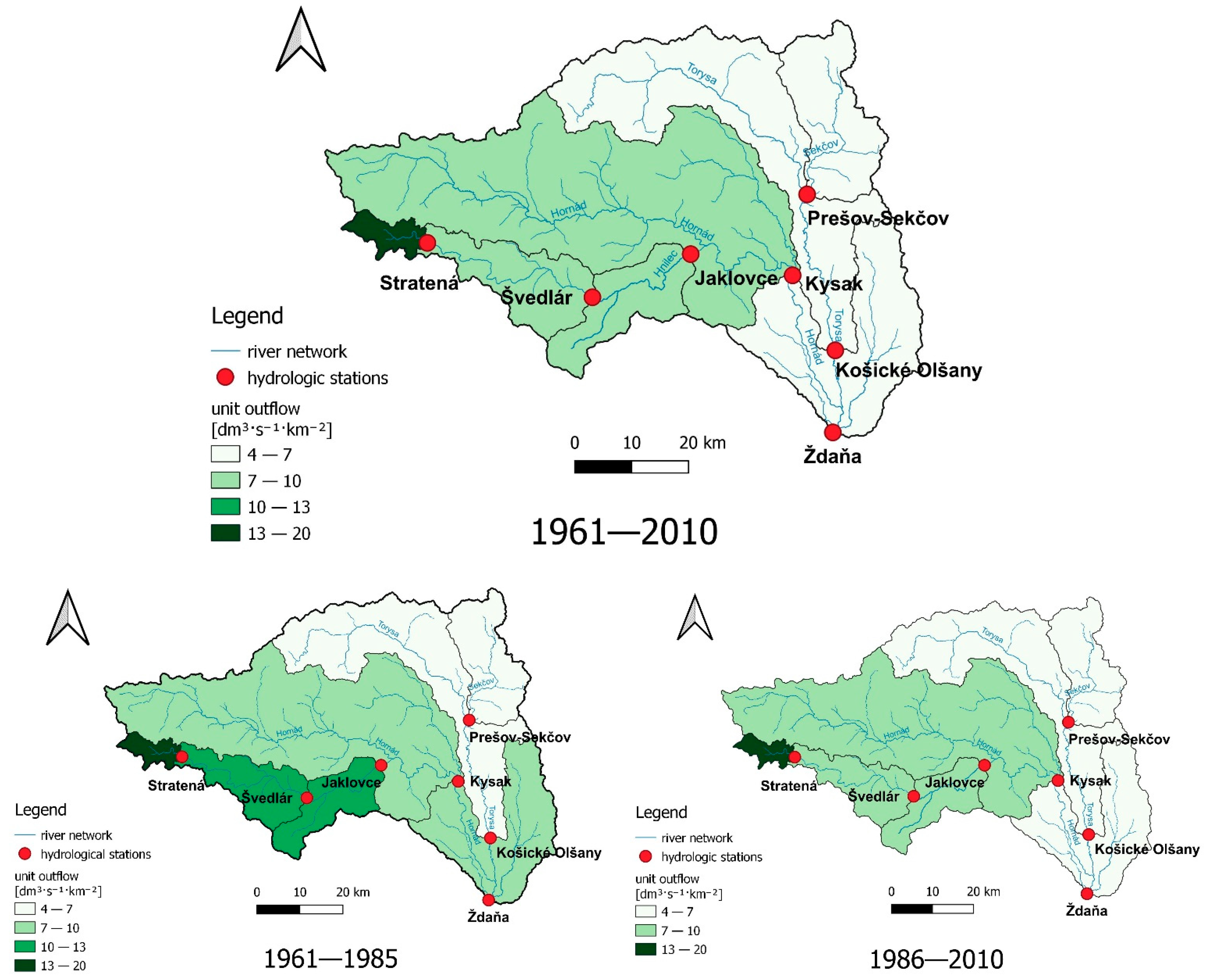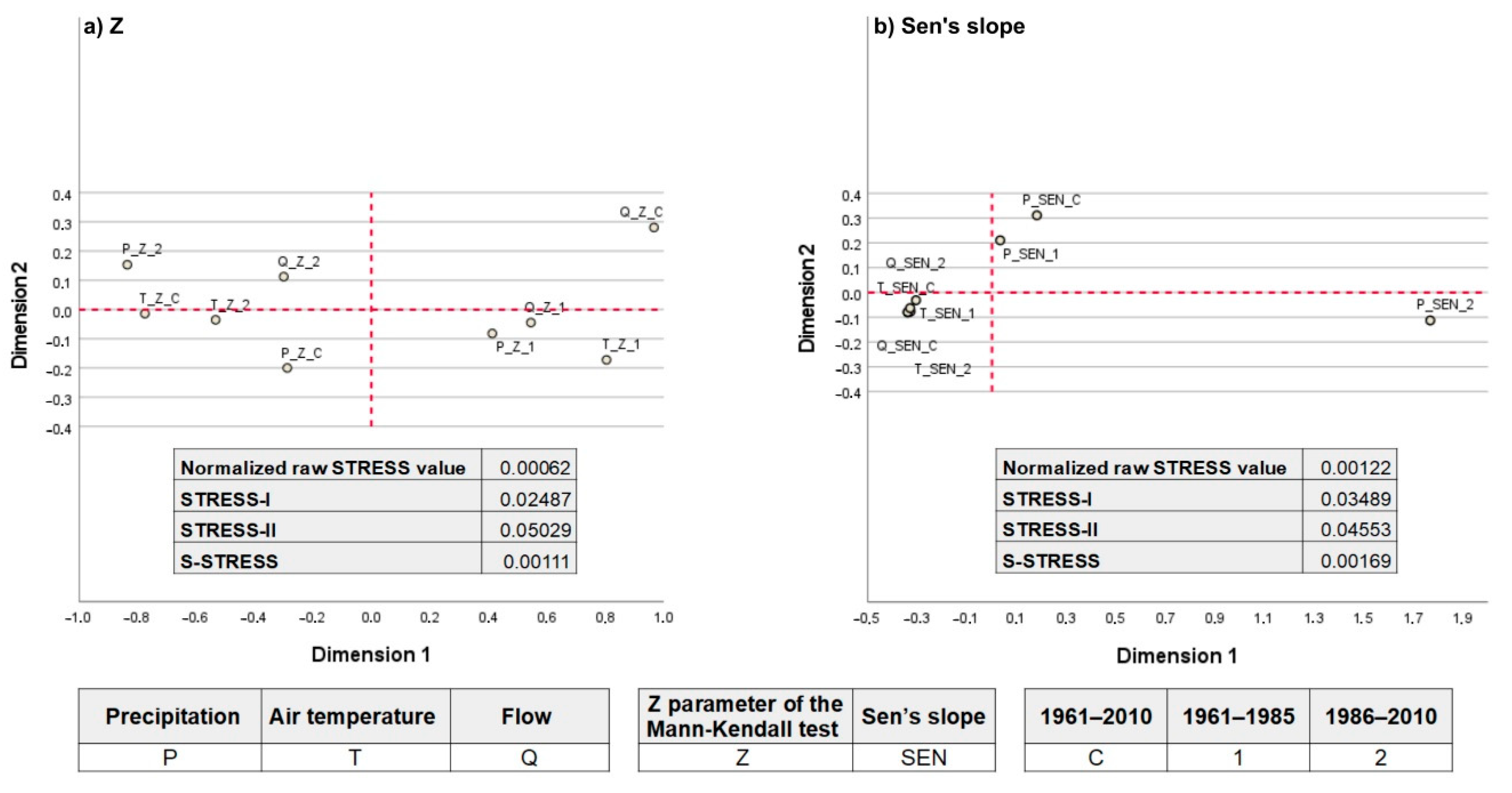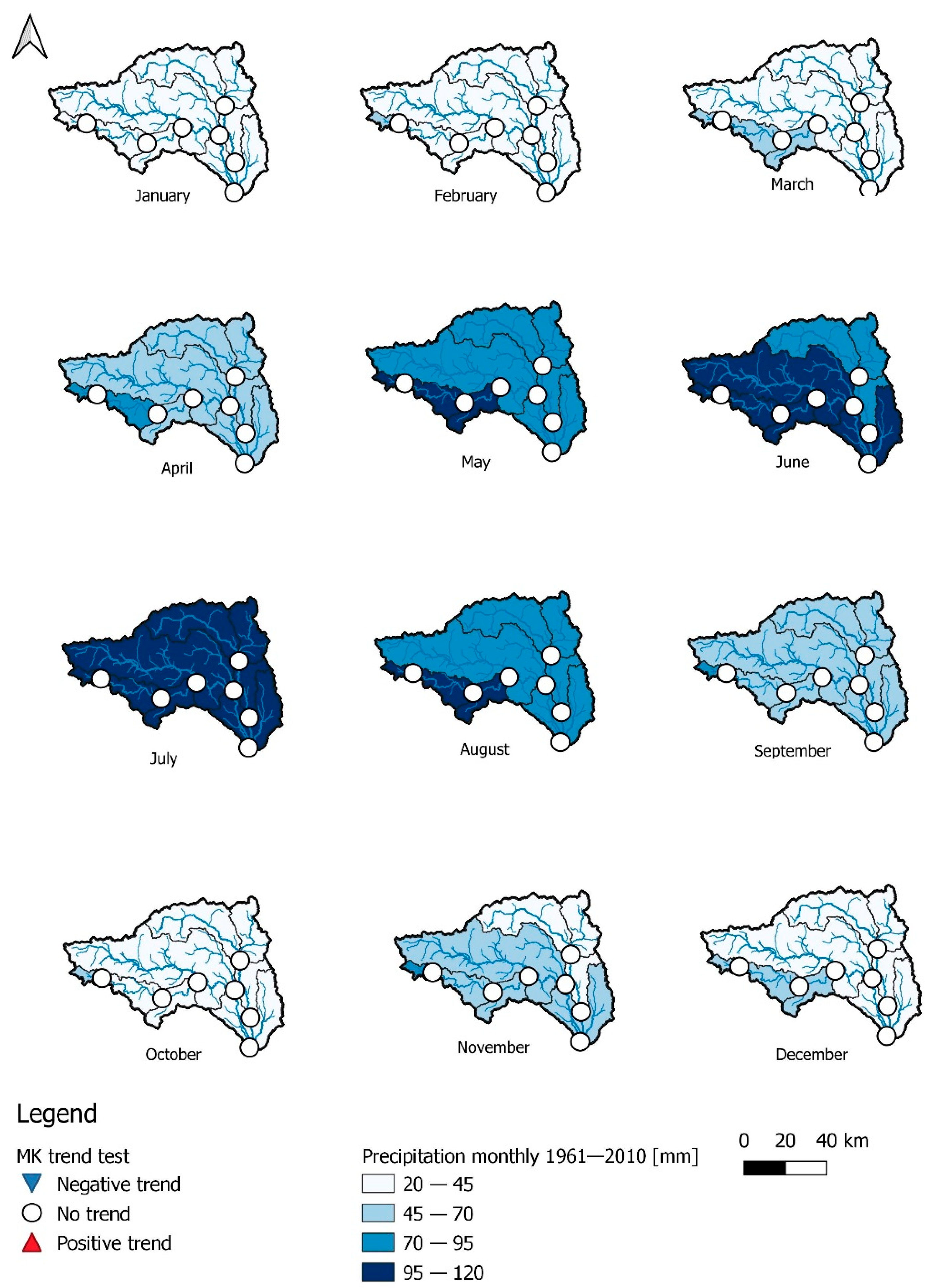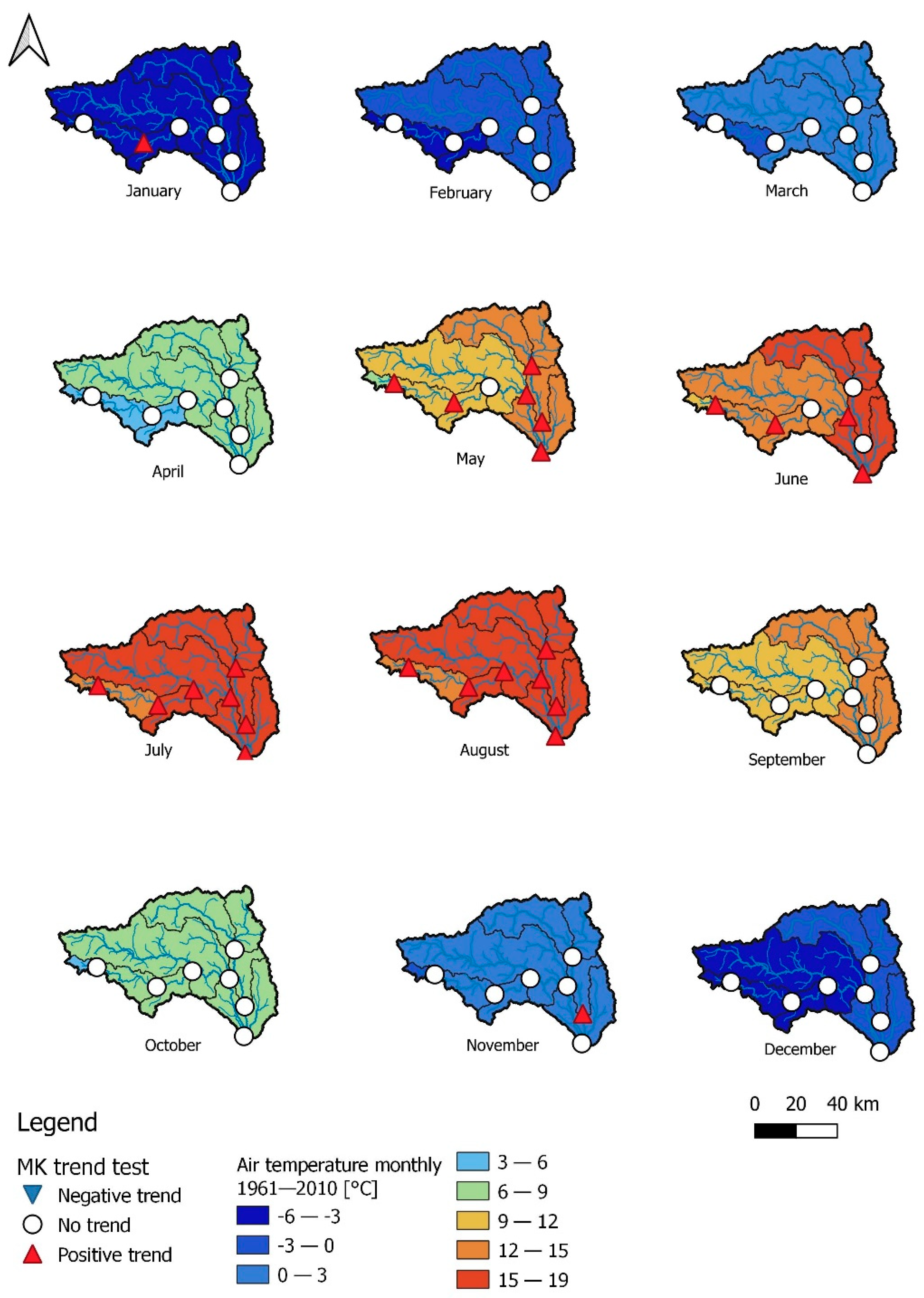Trend Analysis of Selected Hydroclimatic Variables for the Hornad Catchment (Slovakia)
Abstract
:1. Introduction
2. Materials and Methods
2.1. Study Area
2.2. Data and Methods
2.3. Detecting Trends
3. Results and Discussion
3.1. Variability of Hydrometeorological Parameters in the Years 1961–2010
3.1.1. Average Annual Precipitation
3.1.2. Average Annual Air Temperature
3.1.3. Average Annual Flows
3.2. Trends of Hydrometeorological Parameters in the Years 1961–2010
3.2.1. Precipitation
3.2.2. Air Temperature
3.2.3. Flows
3.2.4. Relationships between Trends in Precipitation, Air Temperature and Flow
3.3. Monthly Variability in Precipitation, Air Temperature and Flows
3.4. Discussion
4. Conclusions
Supplementary Materials
Author Contributions
Funding
Institutional Review Board Statement
Informed Consent Statement
Data Availability Statement
Conflicts of Interest
References
- Pekárová, J.; Miklanek, P.; Pekár, J. Long-term trends and runoff fluctuations of European rivers. Climate Variability and Change—Hydrological Impacts. In Proceedings of the Fifth FRIEND World Conference, Havana, Cuba, 27 November–1 December 2006; pp. 520–525. [Google Scholar]
- Stahl, K.; Hisdal, H.; Hannaford, J.; Tallaksen, L.; Van Lanen, H.; Sauquet, E.; Demuth, S.; Fendekova, M.; Jordar, J. Streamflow trends in Europe: Evidence from a dataset of near-natural catchments. Hydrol. Earth Syst. Sci. 2010, 14, 2367–2382. [Google Scholar] [CrossRef] [Green Version]
- Kubiak-Wójcicka, K.; Jamorska, I. An analysis of groundwater drought in combination with meteorological drought. Case study of the Gwda River catchment (northern Poland). Acta Montanistica Slovaca 2022, 27, 667–684. [Google Scholar] [CrossRef]
- Pabón-Caicedo, J.D.; Arias, P.A.; Carril, A.F.; Espinoza, J.C.; Borrel, L.F.; Goubanova, K.; Lavado-Casimiro, W.; Masiokas, M.; Solman, S.; Villalba, R. Observed and Projected Hydroclimate Changes in the Andes. Front. Earth Sci. 2020, 8, 61. [Google Scholar] [CrossRef]
- Šraj, M.; Bezak, N. Comparison of time trend- and precipitation-informed models for assessing design discharges in variable climate. J. Hydrol. 2020, 589, 125374. [Google Scholar] [CrossRef]
- Banda, V.D.; Dzwairo, R.B.; Singh, S.K.; Kanyerere, T. Trend analysis of selected hydro-meteorological variables for the Rietspruit sub-basin, South Africa. J. Water Clim. Chang. 2021, 12, 3099–3123. [Google Scholar] [CrossRef]
- El Aoula, R.; Mahe, G.; Mhammdi, N.; Ezzahouani, A.; Kacimi, I.; Khomsi, K. Evolution of the hydrological regime in relation to climate change: Case of the Bouregreg River basin, Morocco. Geogr. Pol. 2021, 1, 131–147. [Google Scholar] [CrossRef]
- Makungo, R.; Mashinye, M.D. Long-term trends and changes in rainfall magnitude and duration in a semi-arid catchment, South Africa. J. Water Clim. Chang. 2022, 13, 2319. [Google Scholar] [CrossRef]
- Du, P.; Xu, M.; Li, R. Impacts of climate change on water resources in the major countries along the Belt and Road. PeerJ 2021, 9, e12201. [Google Scholar] [CrossRef]
- Hlavčová, K.; Kohnová, S.; Borga, M.; Horvát, O.; Št’astný, P.; Pekárová, P.; Majerčáková, O.; Danáčová, Z. Post-event analysis and flash flood hydrology in Slovakia. J. Hydrol. Hydromech. 2016, 64, 304–315. [Google Scholar] [CrossRef] [Green Version]
- Wałęga, A.; Kowalik, T.; Bogdał, A. Estimating the occurrence of trends in selected elements of a small sub-mountain catchment hydrological regime. Pol. J. Environ. Stud. 2016, 25, 2151–2159. [Google Scholar] [CrossRef]
- Spinoni, J.; Naumann, G.; Vogt, J.V. Pan-European seasonal trends and recent changes of drought frequency and severity. Glob. Planet. Chang. 2017, 148, 113–130. [Google Scholar] [CrossRef]
- Wrzesiński, D. Use of entropy in the assessment of uncertainty of river runoff regime in Poland. Acta Geophys. 2016, 64, 1825–1839. [Google Scholar] [CrossRef] [Green Version]
- Krebs, G.; Camhy, D.; Muschalla, D. Hydro-Meteorological Trends in an Austrian Low-Mountain Catchment. Climate 2021, 9, 122. [Google Scholar] [CrossRef]
- Jalón-Rojas, I.; Castelle, B. Climate Control of Multidecadal Variability in River Discharge and Precipitation in Western Europe. Water 2021, 13, 257. [Google Scholar] [CrossRef]
- Kubiak-Wójcicka, K. Variability of Air Temperature, Precipitation and Outflows in the Vistula Basin (Poland). Resources 2020, 9, 103. [Google Scholar] [CrossRef]
- Stefanidis, S.; Stathis, D. Spatial and Temporal Rainfall Variability over the Mountainous Central Pindus (Greece). Climate 2018, 6, 75. [Google Scholar] [CrossRef] [Green Version]
- Arnell, N.W. Climate change and global water resources. Glob. Environ. Chang. 1999, 9, S31–S49. [Google Scholar] [CrossRef]
- The Intergovernmental Panel on Climate Change (IPCC). Climate Change (IPCC). Climate change 2013: The physical science basis. In Contribution of Working Group I to the 5th Assessment Report of the Intergovernmental Panel on Climate Change; Cambridge University Press: Cambridge, UK; New York, NY, USA, 2013. [Google Scholar]
- Melo, M.; Lapin, M.; Damborska, I. Methods for the design of climate change scenario in Slovakia for the 21st Century. Bull. Geogr. Phys. Geogr. Ser. 2009, 1, 77–90. [Google Scholar] [CrossRef] [Green Version]
- Štefunková, Z.; Hlavčová, K.; Lapin, M. Runoff change scenarios based on regional climate change projections in mountains basin in Slovakia. Contrib. Geophys. Geod. 2013, 43, 327–350. [Google Scholar] [CrossRef] [Green Version]
- Kohnová, S.; Vasilaki, M.; Hanel, M.; Szolgay, J.; Hlavčová, K.; Loukas, A.; Földes, G. Detection of future changes in trends and scaling exponents in extreme short-term precipitation at selected stations in Slovakia. Contrib. Geophys. Geod. 2018, 48, 207–230. [Google Scholar] [CrossRef]
- Fendeková, M.; Horvát, O.; Blaškovičova, L.; Danáčová, Z.; Fendek, M.; Bochníček, O. Prognosis of climate change driven drought in the Poprad, Torysa and Topl’a river basins. Acta Hydrol. Slovaca 2018, 19, 234–243. [Google Scholar]
- Marková, I.; Monoši, M. Expressions of climatic change in Slovak Republic. Ann. Univ. Paedagog. Crac. Stud. Nat. 2020, 5, 145–156. [Google Scholar] [CrossRef]
- Labudová, L.; Faško, P.; Ivaňáková, G. Changes in climate and changing climate regions in Slovakia. Morav. Geogr. Rep. 2015, 23, 71–82. [Google Scholar] [CrossRef] [Green Version]
- Büntgen, U.; Brázdil, R.; Frank, D.; Esper, J. Three centuries of Slovakian drought dynamics. Clim Dyn 2010, 35, 315–329. [Google Scholar] [CrossRef] [Green Version]
- Holko, L.; Sleziak, P.; Danko, M.; Bičárová, S.; Pociask-Karteczka, J. Analysis of changes in hydrological cycle of a pristine mountain catchment.1. Water balance components and snow cover. J. Hydrol. Hydromech. 2020, 68, 180–191. [Google Scholar] [CrossRef]
- Repel, A.; Zelenakova, M.; Vranayova, Z.; Kanalikova, A.; Hlavata, H. Analysis of trends in precipitation time series in selected precipitation stations in eastern Slovakia. IOP Conf. Ser. Earth Environ. Sci. 2020, 444, 012048. [Google Scholar] [CrossRef]
- Blaškovičová, L.; Jeneiová, K.; Melová, K.; Poórová, J.; Liová, S.; Slivková, K.; Síčová, B. Changes in Selected Low-Flow Characteristics in the 2001–2015 Period Compared to the 1961–2000 Reference Period in Slovakia. Climate 2022, 10, 81. [Google Scholar] [CrossRef]
- Kubiak-Wójcicka, K.; Machula, S. Influence of Climate Changes on the State of Water Resources in Poland and Their Use. Geosciences 2020, 10, 312. [Google Scholar] [CrossRef]
- Gudmundsson, L.; Boulange, J.; Do, H.X.; Gosling, S.N.; Grillakis, M.G.; Koutroulis, A.G.; Leonard, M.; Liu, J.; Schmied, H.M.; Papadimitriou, L.; et al. Globally observed trends in mean and extreme river flow attributed to climate change. Science 2021, 371, 1159–1162. [Google Scholar] [CrossRef] [PubMed]
- Bahremand, A.; De Smedt, F. Distributed Hydrological Modeling and Sensitivity Analysis in Torysa Watershed, Slovakia. Water Resour Manag. 2008, 22, 393–408. [Google Scholar] [CrossRef]
- Kliment, Z.; Matoušková, M. Runoff Changes in the Šumava Mountains (Black Forest) and the Foothill Regions: Extent of Influence by Human Impact and Climate Change. Water Resour Manag. 2009, 23, 1813–1834. [Google Scholar] [CrossRef]
- Faško, P.; Kajaba, P.; Markovic, L.; Pecho, J. Trends in heavy precipitation in Slovakia over 1951–2017. EMS Annu. Meet. Abstr. 2018, 15, EMS 2018-462. [Google Scholar]
- Kralovec, V.; Kliment, Z.; Matouškova, M. Evaluation of runoff response on the basis of a comparative paired research in mountain catchments with the different land use: Case study of the Blanice River, Czechia. Geografie 2016, 121, 209–234. [Google Scholar] [CrossRef]
- Zeleňáková, M.; Repel, A.; Vranayová, Z.; Kaposztasová, D.; Abd-Elhamid, H.F. Impact of land use changes on surface runoff in urban areas—Case study of Myslavsky Creek Basin in Slovakia. Acta Montan. Slovaca 2019, 24, 129–139. [Google Scholar]
- Kubiak-Wójcicka, K.; Zelenakova, M.; Purcz, P.; Simovova, D. The use of a Standardized Runoff Indicator for hydrological characterization of selected rivers of Poland and Slovakia. Middle Pomeranian Sci. Soc. Environ. Prot. 2019, 21, 167–183. Available online: http://ros.edu.pl/images/roczniki/2019/010_ROS_V21_R2019.pdf (accessed on 10 October 2021).
- Vido, J.; Nalevanková, P. Drought in the Upper Hron Region (Slovakia) between the Years 1984–2014. Water 2020, 12, 2887. [Google Scholar] [CrossRef]
- Croitoru, A.-E.; Minea, I. The impact of climate changes on rivers discharge in Eastern Romania. Appl. Clim. 2014, 120, 563–573. [Google Scholar] [CrossRef]
- Kubiak-Wójcicka, K.; Pilarska, A.; Kamiński, D. The analysis of Long-Term Trends in the Meteorological and Hydrological Drought Occurrences Using Non-Parametric Methods—Case Study of the Catchment of the Upper Noteć River (Central Poland). Atmosphere 2021, 12, 1098. [Google Scholar] [CrossRef]
- Krajčí, P.; Holko, L.; Parajka, J. Variability of snow line elevation, snow cover area and depletion in the main Slovak basins in winters 2001–2014. J. Hydrol. Hydromech. 2016, 64, 12–22. [Google Scholar] [CrossRef] [Green Version]
- Kędra, M. Altered precipitation and flow patterns in the Dunajec River Basin. Water 2017, 9, 22. [Google Scholar] [CrossRef] [Green Version]
- Górnik, M.; Holko, L.; Pociask-Karteczka, J.; Bičárová, S. Variability of precipitation and runoff in the entire High Tatra Mountains in the period 1961–2010. Pr. Geogr. 2017, 151, 53–74. [Google Scholar] [CrossRef] [Green Version]
- Górnik, M. Changing trends of river flows in the Upper Vistula Basin (East-Central Europe). Acta Geophys. 2020, 68, 495–504. [Google Scholar] [CrossRef] [Green Version]
- Mostowik, K.; Siwek, J.; Kisiel, M.; Kowalik, K.; Krzysik, M.; Plenzler, M.; Rzonca, B. Runoff trends in a changing climate in the Eastern Carpathians (Bieszczady Mountains, Poland). CATENA 2019, 182, 104174. [Google Scholar] [CrossRef]
- Stefanidis, S.; Chatzichristaki, C. Response of soil erosion in a mountains catchment to temperature and precipitation trends. Carpathian J. Earth Environ. Sci. 2017, 12, 35–39. [Google Scholar]
- Kubiak-Wójcicka, K.; Zeleňáková, M.; Blištan, P.; Simonová, D.; Pilarska, A. Influence of climate change on low flow conditions. case study: Laborec river, eastern Slovakia. Ecohydrol. Hydrobiol. 2021, 21, 570–583. [Google Scholar] [CrossRef]
- Młyński, D.; Wałęga, A.; Kuriqi, A. Influence of meteorological drought on environmental flows in mountain catchments. Ecol. Indic. 2021, 133, 108460. [Google Scholar] [CrossRef]
- Borowska-Pakuła, J.; Mięsiak-Wójcik, K. Assessing discharge periodicity in mountain catchments using classified environmental conditions (Tatra Mountains, Poland). J. Mt. Sci. 2022, 19, 16–32. [Google Scholar] [CrossRef]
- IPCC. Climate Change 2022: Impacts, Adaptation and Vulnerability. Contribution of Working Group II to the Sixth Assessment Report of the Intergovernmental Panel on Climate Change; Pörtner, H.-O., Roberts, D., Tignor, M., Poloczanska, E., Mintenbeck, K., Alegría, A., Craig, M., Langsdorf, S., Löschke, S., Möller, V., Okem, A., Rama, B., Eds.; Cambridge University Press: Cambridge, UK; New York, NY, USA, 2022; p. 3056. [Google Scholar] [CrossRef]
- Fan, M.; Xu, J.; Chen, Y.; Fan, M.; Yu, W.; Li, W. Temperature Contributes More than Precipitation to Runoff in the High Mountains of Northwest China. Remote Sens. 2022, 14, 4015. [Google Scholar] [CrossRef]
- Repel, A.; Zeleňáková, M.; Jothiprakash, V.; Hlavatá, H.; Blištan, P.; Gargar, I.; Purcz, P. Long-Term Analysis of Precipitation in Slovakia. Water 2021, 13, 952. [Google Scholar] [CrossRef]
- Zeleňáková, M.; Vido, J.; Portela, M.M.; Purcz, P.; Blištán, P.; Hlavatá, H.; Hluštík, P. Precipitation Trends over Slovakia in the Period 1981–2013. Water 2017, 9, 922. [Google Scholar] [CrossRef] [Green Version]
- Manipulačný Poriadok Pre Vodnú Stabvu Ruizn I, II; Slovenský Vodohospodarsk Vodohospodársky Podnik, Odštepný Závod Košice: Banská Štlavnica, Slovakia, 2017.
- Bahremand, A.; Corluy, J.; Liu, Y.B.; De Smedt, F.; Poorova, J.; Velcicka, L. Stream flow simulation by WetSpa model in Hornad river basin, Slovakia. In Floods, from Defence to Management; Van Alphen, J., van Beek, E., Taal, M., Eds.; Taylor–Francis Group: London, UK, 2005; pp. 67–74. ISBN 0415380502. [Google Scholar]
- CORINE Land Cover (CLC). 2018. Available online: https://land.copernicus.eu/pan-european/corine-land-cover/view (accessed on 1 August 2022).
- Slovak Hydrometeorological Institute. Available online: https://www.intersucho.cz/sk/?mapcountry=sk&from=2022-01-19&to=2022-02-16¤t=2022-02-13 (accessed on 19 January 2022).
- Kendall, M.G. Rank Correlation Measures; Charles Griffin: London, UK, 1975. [Google Scholar]
- Mann, H.B. Non-parametric tests against trend. Econometrica 1945, 13, 245–259. [Google Scholar] [CrossRef]
- Sen, P.K. Estimates of the regression coefficient based on Kendall’s tau. J. Am. Stat. Assoc. 1968, 63, 1379–1389. [Google Scholar] [CrossRef]
- Bulut, O.; Cormier, D.C. Validity Evidence for Progress Monitoring with Star Reading: Slope Estimates, Administration Frequency, and Number of Data Points. Front. Educ. 2018, 3, 68. [Google Scholar] [CrossRef]
- RStudio Team. RStudio: Integrated Development Environment for R; RStudio, PBC: Boston, MA, USA, 2021; Available online: http://www.rstudio.com/ (accessed on 10 October 2022).
- Wickham, H.; Bryan, J.; readxl: Read Excel Files. R Package Version 1.3.1. 2019. Available online: https://CRAN.R-project.org/package=readxl (accessed on 25 February 2022).
- Pohlert, T.; trend: Non-Parametric Trend Tests and Change-Point Detection. R Package Version 1.1.4. 2020. Available online: https://CRAN.R-project.org/package=trend. (accessed on 25 February 2022).
- Zaborski, A. Skalowanie wielowymiarowe. In Metody Statystycznej Analizy Wielowymiarowej w Badaniach Marketingowych; Gatnar, E., Walesiak., M., Eds.; Wydawnictwo Akademii Ekonomicznej im. Oskara Langego we Wrocławiu: Wrocław, Poland, 2004; pp. 246–282. [Google Scholar]
- Machado, J.A.T. Fractal and Entropy Analysis of the Dow Jones Index Using Multidimensional Scaling. Entropy 2020, 22, 1138. [Google Scholar] [CrossRef] [PubMed]
- Pekasiewicz, D.; Szczukocka, A. 2017, Analiza rozwoju usług finansowo-bankowych w Polsce na tle krajów Unii Europejskiej. Wiadomości Stat. 2017, 10, 38–51. [Google Scholar] [CrossRef]
- Vido, J.; Nalevanková, P.; Valach, J.; Šustek, Z.; Tadesse, T. Drought Analyses of the Horné Požitavie Region (Slovakia) in the Period 1966–2013. Hindawi Adv. Meteorol. 2019, 2019, 3576285. [Google Scholar] [CrossRef]
- Wang, Y.-H.; Magnusdottir, G.; Stern, H.; Tian, X.; Yu, Y. Decadal variability of the NAO: Introducing an augmented NAO index. Geophys. Res. Lett. 2012, 39, L21702. [Google Scholar] [CrossRef] [Green Version]
- Woollings, T.; Franzke, C.; Hodson, D.L.R.; Dong, B.; Barnes, E.A.; Raible, C.C.; Pinto, J.G. Contrasting interannual and multidecadal NAO variability. Clim. Dyn. 2015, 45, 539–556. [Google Scholar] [CrossRef] [Green Version]
- Espinosa, L.A.; Portela, M.M. Grid-Point Precipitation Trends, Teleconnection Patterns, and Regionalised Droughts in Portugal (1919–2019). Water 2022, 14, 1863. [Google Scholar] [CrossRef]
- Labudová, L.; Šťastný, P.; Trizna, M. The north atlantic oscillation and winter precipitation totals in Slovakia. Morav. Geogr. Rep. 2013, 21, 38–49. [Google Scholar] [CrossRef] [Green Version]
- Zeleňáková, M.; Purcz, P.; Blištan, P.; Vranayová, Z.; Hlavatá, H.; Diaconu, D.C.; Portela, M.M. Trends in precipitation and temperatures in Eastern Slovakia (1962–2014). Water 2018, 10, 727. [Google Scholar] [CrossRef] [Green Version]
- Danáčová, Z.; Jeneinová, K.; Blaškovičová, L. Hydrological situation on Slovak rivers from the point of view of hydrological drought assessment in the period 2011–2020. Acta Hydrol. Slovaca 2021, 22, 230–236. [Google Scholar] [CrossRef]
- Kohler, T.; Maselli, D. Mountains and Climate Change—From Understanding to Action. Produced with an International Team of Contributors; Geographica Bernensia and Swiss Agency for Development and Cooperation: Bern, Switzerland, 2009. [Google Scholar]
- Mastrotheodoros, T.; Pappas, C.; Molnar, P.; Burlando, P.; Manoli, G.; Parajka, J.; Rigon, R.; Szeles, B.; Bottazzi, M.; Hadjidoukas, P.; et al. More green and less blue water in the Alps during warmer summers. Nat. Clim. Chang. 2020, 10, 155–161. [Google Scholar] [CrossRef]
- Xu, J.; Gao, X.; Yang, Z.; Xu, T. Trend and Attribution Analysis of Runoff Changes in the Weihe River Basin in the Last 50 Years. Water 2021, 14, 47. [Google Scholar] [CrossRef]
- Bacanli, Ü.G. Trend analysis of precipitation and drought in the Aegean region, Turkey. Meteorol. Appl. 2017, 24, 239–249. [Google Scholar] [CrossRef]
- Hänsel, S.; Ustrnul, Z.; Łupikasza, E.; Skalak, P. Assessing seasonal drought variations and trends over Central Europe. Adv. Water Resour. 2019, 127, 53–75. [Google Scholar] [CrossRef]








| Hydrological Stations | River | Catchment Area (km2) | River Length (km) | Minimum Elevation m a.s.l. | Maximum Elevation m a.s.l. | Average Elevation m a.s.l. |
|---|---|---|---|---|---|---|
| Stratená | Hnilec | 64.67 | 45.7 | 794.7 | 1932.1 | 1066.7 |
| Švedlár | Hnilec | 352.01 | 60.8 | 442.8 | 1932.1 | 879.3 |
| Jaklovce | Hnilec | 604.02 | 36.2 | 328.8 | 1932.1 | 800.4 |
| Kysak | Hornad | 2337.00 | 118.6 | 235.2 | 1932.1 | 672.2 |
| Prešov-Sekčov | Sekčov | 350.91 | 37.9 | 234.5 | 1049.9 | 427.6 |
| Košické Olšany | Torysa | 1296.26 | 125.4 | 185.9 | 1261.1 | 507.6 |
| Ždaná | Hornad | 4249.14 | 39.8 | 167.7 | 1932.1 | 579.1 |
| Hydrological Stations | River | Forest (%) | Arable Land (%) | Urban Fabric (%) | Heterogeneous Agricultural Area (%) | Pastures (%) | Scrub and Herbaceous Vegetation (%) |
|---|---|---|---|---|---|---|---|
| Stratená | Hnilec | 78.80 | - | - | 2.34 | 6.72 | 11.40 |
| Švedlár | Hnilec | 68.50 | 1.86 | 1.15 | 6.51 | 5.00 | 16.60 |
| Jaklovce | Hnilec | 73.80 | 1.88 | 1.87 | 6.13 | 4.65 | 11.20 |
| Kysak | Hornad | 57.80 | 18.00 | 3.97 | 7.01 | 3.40 | 6.69 |
| Prešov-Sekčov | Sekčov | 34.20 | 47.50 | 8.05 | 9.22 | 7.83 | 1.21 |
| Košické Olšany | Torysa | 69.60 | 16.30 | 3.49 | 4.26 | 4.14 | 1.49 |
| Ždaná | Hornad | 49.80 | 24.50 | 5.31 | 7.60 | 5.95 | 4.95 |
| Hydrological Stations | River | Average Discharge (m3·s−1) /Unit Outflow (dm3·s−1·km−2) | ||
|---|---|---|---|---|
| 1961–1985 | 1986–2010 | 1961–2010 | ||
| Stratená | Hnilec | 1.29/19.95 | 1.08/16.72 | 1.19/18.34 |
| Švedlár | Hnilec | 3.61/10.26 | 3.42/9.72 | 3.52/9.99 |
| Jaklovce | Hnilec | 6.43/10.65 | 5.59/9.25 | 6.01/9.95 |
| Kysak | Hornad | 18.24/7.80 | 16.86/7.21 | 17.55/7.51 |
| Prešov-Sekčov | Sekčov | 2.27/6.48 | 1.72/4.90 | 2.00/5.69 |
| Košické Olšany | Torysa | 8.07/6.23 | 7.55/5.83 | 7.81/6.03 |
| Ždaná | Hornad | 30.59/7.19 | 27.93/6.57 | 29.26/6.89 |
| Hydrological Stations | River | Average Precipitation in Years (mm) | Average Air Temperature in Years (℃) | ||||
|---|---|---|---|---|---|---|---|
| 1961–1985 | 1986–2010 | 1961–2010 | 1961–1985 | 1986–2010 | 1961–2010 | ||
| Stratená | Hnilec | 879.1 | 950.6 | 914.8 | 3.99 | 4.57 | 4.28 |
| Švedlár | Hnilec | 850.8 | 901.1 | 876.4 | 4.84 | 5.40 | 5.12 |
| Jaklovce | Hnilec | 839.0 | 870.1 | 854.6 | 5.41 | 5.90 | 5.65 |
| Kysak | Hornad | 739.5 | 760.8 | 750.2 | 6.06 | 6.57 | 6.32 |
| Prešov-Sekčov | Sekčov | 671.0 | 693.9 | 682.5 | 7.08 | 7.65 | 7.36 |
| Košické Olšany | Torysa | 634.7 | 650.0 | 642.3 | 7.08 | 7.63 | 7.35 |
| Ždaná | Hornad | 720.8 | 736.3 | 728.6 | 6.54 | 7.11 | 6.83 |
| Stations | Parameters | Years | ||
|---|---|---|---|---|
| 1961–2010 | 1961–1985 | 1986–2010 | ||
| Ždaná | p-value (MK test) Sen’s slope | 0.0682 | 0.4691 | 0.0008 |
| 1.9926 | 2.2051 | 8.1043 | ||
| Košické Olšany | p-value (MK test) Sen’s slope | 0.0682 1.9204 | 0.1682 3.4245 | 0.0072 6.5628 |
| Prešov-Sekčov | p-value (MK test) Sen’s slope | 0.0413 | 0.4691 | 0.0035 |
| 2.0211 | 2.1309 | 8.6840 | ||
| Kysak | p-value (MK test) Sen’s slope | 0.0879 2.2103 | 0.5912 1.3042 | 0.0005 8.8045 |
| Jaklovce | p-value (MK test) Sen’s slope | 0.0322 2.6718 | 0.4137 1.7374 | 0.0002 9.9027 |
| Švedlár | p-value (MK test) Sen’s slop | 0.0153 3.2358 | 0.3875 1.6311 | 0.0008 9.6906 |
| Stratená | p-value (MK test) Sen’s slop | 0.0095 3.8809 | 0.8335 1.5205 | 0.0014 12.0445 |
| Stations | Parameters | Years | ||
|---|---|---|---|---|
| 1961–2010 | 1961–1985 | 1986–2010 | ||
| Ždaná | p-value (MK test) Sen’s slope | 0.0016 | 0.9070 | 0.0095 |
| 0.0230 | 0.0032 | 0.0521 | ||
| Košické Olšany | p-value (MK test) Sen’s slope | 0.0031 0.0230 | 16.000 0.0110 | 0.0142 0.0525 |
| Prešov-Sekčov | p-value (MK test) Sen’s slope | 0.0010 | 0.6913 | 0.0072 |
| 0.0239 | 0.0058 | 0.0472 | ||
| Kysak | p-value (MK test) Sen’s slope | 0.0034 0.0204 | 0.9441 −0.0010 | 0.0063 0.0549 |
| Jaklovce | p-value (MK test) Sen’s slope | 0.0040 0.0197 | 0.9070 −0.0036 | 0.0063 0.0560 |
| Švedlár | p-value (MK test) Sen’s slop | 0.0012 0.0216 | 0.7261 −0.0043 | 0.0095 0.0498 |
| Stratená | p-value (MK test) Sen’s slop | 0.0016 0.0218 | 0.5912 −0.0097 | 0.0161 0.0467 |
| Stations | Parameters | Years | ||
|---|---|---|---|---|
| 1961–2010 | 1961–1985 | 1986–2010 | ||
| Ždaná | p-value (MK test) Sen’s slope | 0.9333 | 0.5912 | 0.0063 |
| 0.0058 | 0.1649 | 0.6206 | ||
| Košické Olšany | p-value (MK test) Sen’s slope | 0.4124 0.0244 | 0.1290 0.1388 | 0.0109 0.1340 |
| Prešov-Sekčov | p-value (MK test) Sen’s slope | 0.2768 | 0.7614 | 0.2525 |
| −0.0099 | 0.0065 | 0.0211 | ||
| Kysak | p-value (MK test) Sen’s slope | 0.9200 0.0081 | 0.6238 0.1140 | 0.0142 0.3565 |
| Jaklovce | p-value (MK test) Sen’s slope | 0.5924 −0.0106 | 0.7614 0.0213 | 0.0235 0.1015 |
| Švedlár | p-value (MK test) Sen’s slop | 0.8409 0.0030 | 0.6572 0.0158 | 0.0336 0.0642 |
| Stratená | p-value (MK test) Sen’s slop | 0.0429 −0.0063 | 1.0000 −0.0005 | 0.0298 0.0123 |
Disclaimer/Publisher’s Note: The statements, opinions and data contained in all publications are solely those of the individual author(s) and contributor(s) and not of MDPI and/or the editor(s). MDPI and/or the editor(s) disclaim responsibility for any injury to people or property resulting from any ideas, methods, instructions or products referred to in the content. |
© 2023 by the authors. Licensee MDPI, Basel, Switzerland. This article is an open access article distributed under the terms and conditions of the Creative Commons Attribution (CC BY) license (https://creativecommons.org/licenses/by/4.0/).
Share and Cite
Kubiak-Wójcicka, K.; Nagy, P.; Pilarska, A.; Zeleňáková, M. Trend Analysis of Selected Hydroclimatic Variables for the Hornad Catchment (Slovakia). Water 2023, 15, 471. https://doi.org/10.3390/w15030471
Kubiak-Wójcicka K, Nagy P, Pilarska A, Zeleňáková M. Trend Analysis of Selected Hydroclimatic Variables for the Hornad Catchment (Slovakia). Water. 2023; 15(3):471. https://doi.org/10.3390/w15030471
Chicago/Turabian StyleKubiak-Wójcicka, Katarzyna, Patrik Nagy, Agnieszka Pilarska, and Martina Zeleňáková. 2023. "Trend Analysis of Selected Hydroclimatic Variables for the Hornad Catchment (Slovakia)" Water 15, no. 3: 471. https://doi.org/10.3390/w15030471
APA StyleKubiak-Wójcicka, K., Nagy, P., Pilarska, A., & Zeleňáková, M. (2023). Trend Analysis of Selected Hydroclimatic Variables for the Hornad Catchment (Slovakia). Water, 15(3), 471. https://doi.org/10.3390/w15030471









